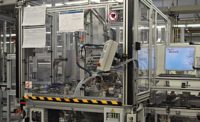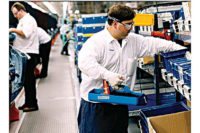Contrary to widespread public concern about robots taking away jobs, people still play a key role on assembly lines. In fact, people still perform 72 percent of manufacturing tasks.
Yet, despite that overwhelming ratio, there’s an almost universal lack of data into the activities that people perform in a factory. This analytical gap limits manufacturers’ ability to make informed decisions on capacity planning, workforce management, process engineering and other strategic domains.
The standard practices for gathering and analyzing tasks done by people—and the foundation of holistic manufacturing practices like lean and Six Sigma—are time and motion studies. While these techniques are still valid, they are difficult to scale, return incomplete data sets, and are subject to observation biases. In the age of Industry 4.0, manufacturers need larger and more complete data sets from manual tasks to empower workers to contribute value to their fullest potential.
This was the challenge faced by manufacturing management at Hella, a Tier 1 automotive supplier based in Lippstadt, Germany. One of the top 50 automotive suppliers in the world, Hella manufactures lighting, electronic components and other parts. Worldwide, it employs some 40,000 people in more than 100 locations in 35 countries.
To increase operational efficiency at the company’s assembly plant in Dhankot, India, managers are working with Drishti Technologies Inc., whose AI-powered manufacturing technology uses video analytics, data and insights to help manufacturers measure and optimize manual processes.
With Drishti cameras and streaming video analysis deployed on one of Hella’s sensor assembly lines, the Hella team made a series of discoveries. First, the massive volume of cycle time data available from Drishti quickly revealed slowdowns in stations that were not originally the focus of improvement efforts. Second, by watching video footage from those stations, the team understood that the physical station configuration was slowing down the workers.
In fact, the station setup was causing ergonomic concerns. Because the worker was reaching with his right arm across to the left side of the station, each cycle required a twisting motion that led to fatigue.
“Because our focus had been on the station we thought was the bottleneck, we had overlooked this potential for slowdowns and fatigue,” says Ram Singh Khangarote, operational excellence and operation product manager at the plant. “Within a few minutes of viewing the video footage from Drishti, our team had ideas to reconfigure the station to make it more comfortable for the line associates, and shortening every cycle time. And most importantly, our line associates are healthier, happier and more productive.”
Once the Dhankot team learned the true cause of line slowdowns, they were able to improve line balancing. The Drishti investment paid for itself in less than six months.
“This is the second instance of finding significant improvement opportunities using Drishti,” says Huri Mendoza, head of operational excellence at Hella. “In 2020, we reduced cycle times at our plant in Guanajuato, Mexico. Now we’re seeing value in Dhankot, as well.
“Drishti’s technology helps us achieve operational excellence by augmenting our extremely capable workforce and empowering them with the tools they need to perform their jobs even better.”
The Dhankot plant deployment is one of several ongoing collaborations between Hella and Drishti. Drishti streams video at every station on a line, then uses proprietary AI networks to translate video streams into data, a technique called action recognition. The line-level data on cycles and actions helps manufacturers improve productivity, quality and adherence with standardized work.
“Drishti’s action recognition technology provides manufacturers with a clear competitive edge, as they can see improvement opportunities on assembly lines that are otherwise hidden,” says Gary Jackson, CEO of Drishti. “Hella’s success with Drishti is in line with what we’re seeing across the automotive industry, as well as in other verticals like electronics and medical devices”
For more information on video analytics technology, visit drishti.com.





